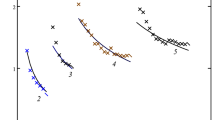Abstract
A relationship between the energy and length of a covalent bond is derived from the theory of generalized charges, the asymptotic approximation of quantum mechanics for interatomic forces, which relies upon the model of multicomponent electron gas. The new relationship for the ground state of diatomic molecules is obtained in the form of analytical expressions without empirical coefficients; characteristics of electronic configuration are its parameters. Fairly good agreement between the results of a priori calculations and the experimental data for various molecules is demonstrated.
Similar content being viewed by others
References
I. G. Kaplan, Introduction to the Theory of Molecular Interactions (Nauka, Moscow, 1982) [in Russian].
S. Fudzinaga, The Molecular Orbitals Method (Mir, Moscow, 1983) [in Russian].
Theory of the Inhomogeneous Electron Gas, Ed. by S. S. Lundkvist and N. March (Springer, 1983; Mir, Moscow, 1987).
A. M. Dolgonosov, Russ. J. Inorg. Chem. 45, 997 (2000).
A. M. Dolgonosov, Russ. J. Phys. Chem. 74 (Suppl. 2), 324 (2000).
A. M. Dolgonosov, The Electron Gas Model and Theory of Generalized Charges for the Description of Interatomic Interactions and Adsorption (LIBROKOM, Moscow, 2009) [in Russian].
A. M. Dolgonosov, Russ. J. Phys. Chem. A 82, 2079 (2008).
A. M. Dolgonosov, Russ. J. Phys. Chem. 75, 1659 (2001).
A. M. Dolgonosov, Russ. J. Phys. Chem. 76, 993 (2002).
A. M. Dolgonosov, Nonspecific Selectivity in the Problem of Modeling High-Performance Chromatography (KRASAND, Moscow, 2012) [in Russian].
N. N. Avgul’, A. V. Kiselev, and D. P. Poshkus, Adsorption of Gases and Vapors on Uniform Surfaces (Khimiya, Moscow, 1975) [in Russian].
A. I. Pertsin and A. I. Kitaigorodsky, The Atom–Atom Potential Method in the Physics and Chemistry of Organic Molecular Solids (Springer, Berlin/New York/Tokyo, 1986).
A. M. Dolgonosov, Russ. J. Inorg. Chem. 60, 194 (2015).
A. M. Dolgonosov, Russ. J. Phys. Chem. 76, 2015 (2002).
A. M. Dolgonosov, Russ. J. Phys. Chem. 77, 764 (2003).
Molecular Constants of Inorganic Compounds: A Handbook, Ed. by K. S. Krasnov (Khimiya, Leningrad, 1979) [in Russian].
CRC Handbook of Chemistry and Physics, Ed. by K. S. Lide (CRC, Boca Raton, FL, 2005). http://www.hbcpnetbase.com.
Author information
Authors and Affiliations
Corresponding author
Additional information
Original Russian Text © A.M. Dolgonosov, 2017, published in Zhurnal Neorganicheskoi Khimii, 2017, Vol. 62, No. 3, pp. 330–336.
Rights and permissions
About this article
Cite this article
Dolgonosov, A.M. The universal relationship between the energy and length of a covalent bond derived from the theory of generalized charges. Russ. J. Inorg. Chem. 62, 344–350 (2017). https://doi.org/10.1134/S0036023617030068
Received:
Published:
Issue Date:
DOI: https://doi.org/10.1134/S0036023617030068



